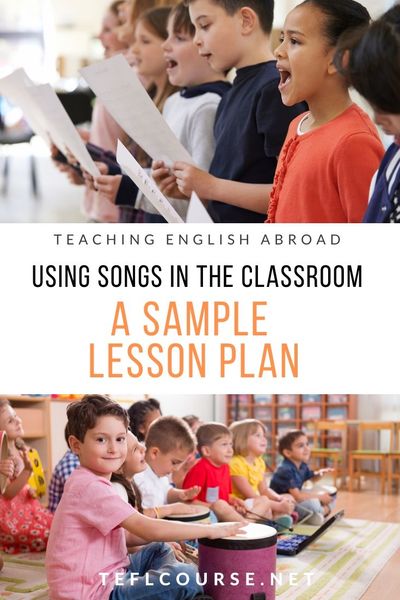Using Songs in the Lesson: a Sample Plan

Many of us, who have had the opportunity to learn a new language have this exciting memory of learning a non-native language even though it could have been just a word or eventually mastering the language itself but, till date have that in our memory bank and access it as and when necessary. In many cases it often beings with a song where we pick up a few words when we are listing to it and slowly try to build up our vocabulary and potentially develop an interest in learning that new language.
Table of Contents
Do you want to teach English abroad? Take a TEFL course!
This post was written by our TEFL certification graduate Nagashree C. Please note that this blog post might not necessarily represent the beliefs or opinions of ITTT.
Reasons to Use Songs
Songs are a way of not only learning something new, but it is also a very effective way of connecting, maintaining interest especially of young learners and managing the classroom. Songs are universally appealing hence, effective in connecting people across cultures, borders, and languages. With the use of songs, even someone who has zero knowledge about the language with constant exposure to hearing and practicing learns to say the words and apply the correct intonations while singing as if sung by a native speaker. Songs have a unique power of holding attention and creating interest that is quite unparalleled to any other form of learning.
One of the earliest memories of learning for a child is through songs, a young child's brain is like a sponge willing to soak up any information you provide it with and retain it for a lifetime. Therefore while teaching young children it is very important to pick the appropriate kind of songs and this holds across age groups. While selecting songs as a medium of teaching one must ensure the songs selected has the necessary vocabulary that matches the language level of the students and serves as a supporting aid to lesson planned. It must not deviate from the topic intended to be covered. As with all materials used it is important to ensure that the chosen song does not have any cultural misappropriations.

Also Read: Do I need a passport to teach English abroad?
Lesson Plan
Let us now look at an example lesson using the ESA method in a kindergarten class learning about family and relationships.
- Teacher: Mrs. Oregano
- Time: 60 minutes
- Student level: Beginners.
- Expected number of Students: 6
- Learners Objective: To be able to use fingers and associate each finger as a way of identifying * relations in the family.
Personal Aims: To ensure the students are engaging, learning and participating during the hour.
Anticipated problems for students: Getting distracted or distracting others.
Solution: Call out the name of the individual causing disruption and asking to stay focused to have fun and learn along with others.

Also Read: Can Americans teach English in Europe?
Anticipated problems for Teacher: Not being able to hold attention for a long time.
Solution: Being flexible on the lesson plan and making changes as necessary, giving short breaks for the children to drink water or use the toilet. Keeping activities and games short and simple so the interest is not exhausted.
Teaching Aids: CD player, printed copies of family members and a picture of a palm with 5 fingers, glue, whiteboard, worksheets.
Lesson: Finger Family.
Engage and Study Phase: After a brief meet and greet session with the students in the class, the teacher shows a family photo as an example and asks the class what are different relationships they can recognize from the photo. Next shows a picture of a baby or a grandparent and asks who among the 6 students live with a baby or a grandparent. Similarly shows pictures of other relations such as a mother, father, uncle or aunt and continues to get answers and teach words to express and identify these relationships.

Also Read: How much can I earn teaching English in France?
Next, get the group to stand together and sing the family song using fingers by associating thumb finger as father finger, the index finger as mother finger, middle finger as the brother's finger, ring finger as the sister's finger and the little finger as the baby finger.
Activate Phase: Before the end of the session, give out a paper with a hand-printed on it, along with pictures of a baby, a boy, a girl, parents, and grandparents and work with the children to glue them on the paper.
Expected result: By the end of the class, the students can sing the family song and identify relationships in a family.
Do you want to teach English abroad? Take a TEFL course!
Apply now & get certified to teach english abroad!
Speak with an ITTT advisor today to put together your personal plan for teaching English abroad.
Send us an email or call us toll-free at 1-800-490-0531 to speak with an ITTT advisor today.
Related Articles:
- What to Watch Out for Before Signing Your TEFL Contract in China
- Guide To Writing A TEFL Resume That Will Get You Hired
- The Best Apps to Have on Your Phone While Teaching English Abroad
- 7 Steps to Paying Off Your Student Loans While Teaching English Abroad
- 5 Reasons Why Teaching English Abroad Enhances Your Career Prospects
- Two Traveling Teachers Share What It's Like Teaching English Abroad as a Couple




